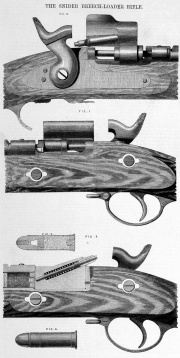Snider-Enfield Rifle

The British .577 Snider-Enfield was a type of breech loading rifle. The action had been invented by Jacob Snider, a Dutch-American wine merchant from Philadelphia. This was one of the most widely used of the Snider varieties. It was adopted by Britain as a conversion system for its ubiquitous Enfield 1853 rifled musket muzzle loading armament.
In trials, the Snider Pattern 1853 conversions proved both more accurate than the original Pattern 1853s and could be fired much faster as well.
From 1866 the rifles were converted in large numbers at the Royal Small Arms Factory (RSAF) Enfield beginning with the initial pattern, the Mark I.
New rifles started as Pattern 1853s, but received a new breech-block/receiver assembly. Converted rifles retained the original iron barrel, furniture, locks and hammer.
The Mark III rifles were newly-made, with steel barrels which were so marked, flat nosed hammers, feature a latch-locking breech block.
1874 The rifle was gradually phased out as the Martini-Henry Rifle was introduced from this year; it was still used by volunteer and militia forces until the late 1880s.
See Also
Sources of Information
- [1] Wikipedia

